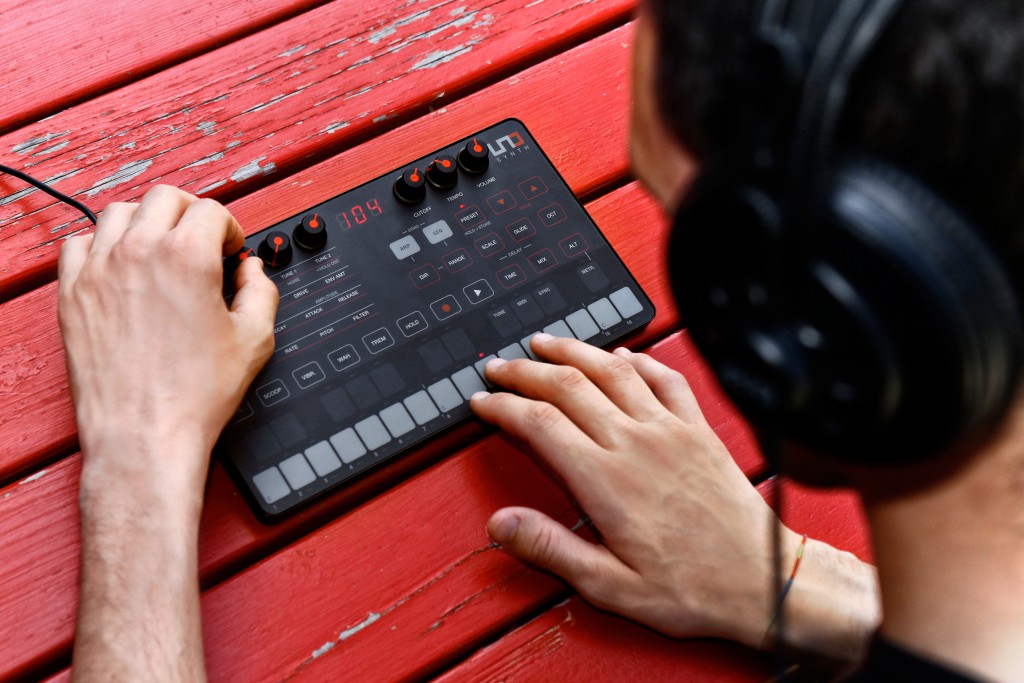
Choosing a good mini synthesizer can be a fantastic way to expand your creative toolset while enjoying the tactile music-making experience only a hardware synth can provide. And as you diligently research your mini synthesizer options, questions arise: should I get an analog or digital synth? What’s the difference between a sequencer and an arpeggiator, and what’s the purpose of each? You deserve answers — let’s dig in.
What is the difference between monophonic and polyphonic synthesizers?
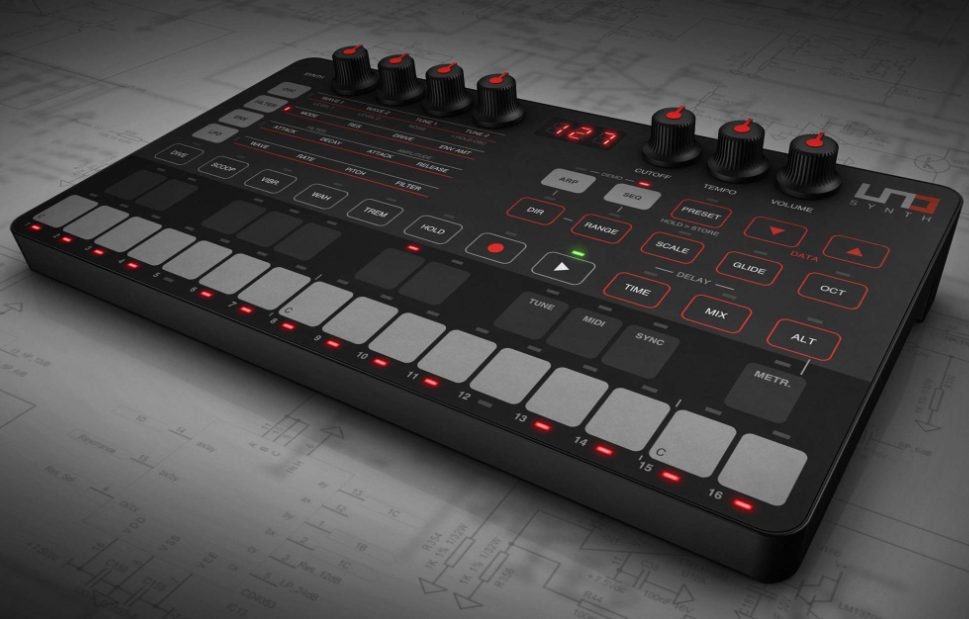
When we talk about whether a synthesizer is monophonic or polyphonic, we’re talking about how many notes you can play simultaneously. The short explanation is that a monophonic synthesizer, like the IK Multimedia Uno Synth, can only produce one note at a time — playing a new note will end the sound you hear from the first note.
With a polyphonic synthesizer, like the Sequential Take 5, you can play multiple notes simultaneously. When you want to play chords, or notes that sustain while new notes are played, you need a polyphonic synthesizer. If you intend to play bass lines and leads, you’ll get the sound you’re looking for in a monophonic synthesizer.
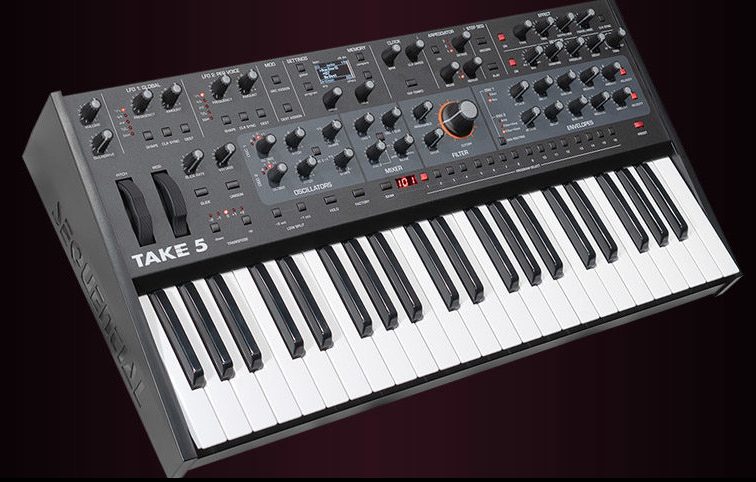
If we want to go a bit deeper, a true polyphonic synthesizer will have a separate internal signal path for each polyphonic voice. That’s why polyphonic analog synthesizers are more expensive than mono synths: a 16-voice analog synthesizer essentially has 16 mono synths built into it, each ready to reproduce a single voice of polyphony. Digital synths obviously don’t need multiple redundant analog circuits, only the processing power required to produce however many individual voices, which is why digital polyphonic synths are much more common and affordable than analog polyphonic synthesizers.
- Monophonic synthesizers only play one note at a time, perfect for bass lines and leads
- Polyphonic synthesizers can play multiple notes simultaneously, dictated by the synth’s number of voices
- Polyphonic isn’t necessarily “better” than mono, you’ll find each excels in different musical applications
What is the difference between a MIDI controller and a synthesizer?

A synthesizer is an instrument that is designed to generate sounds on its own, with audio outputs that can be connected to a mixer, PA system, or recording device. A MIDI controller like the Novation Launchkey 25 MKIII is designed to control other MIDI-capable instruments and other devices, and connects to them with a digital MIDI connection.
On its own, a MIDI controller does not generate any sounds: it is used to control a MIDI-capable instrument like a synthesizer or drum machine. The MIDI connection is not audio: it is a series of digital commands that tell an instrument what notes to play, how long to play them, and many other things. In other words, a synthesizer is a standalone instrument: a MIDI controller is a remote control for controlling a separate MIDI-capable instrument, whether hardware or software.
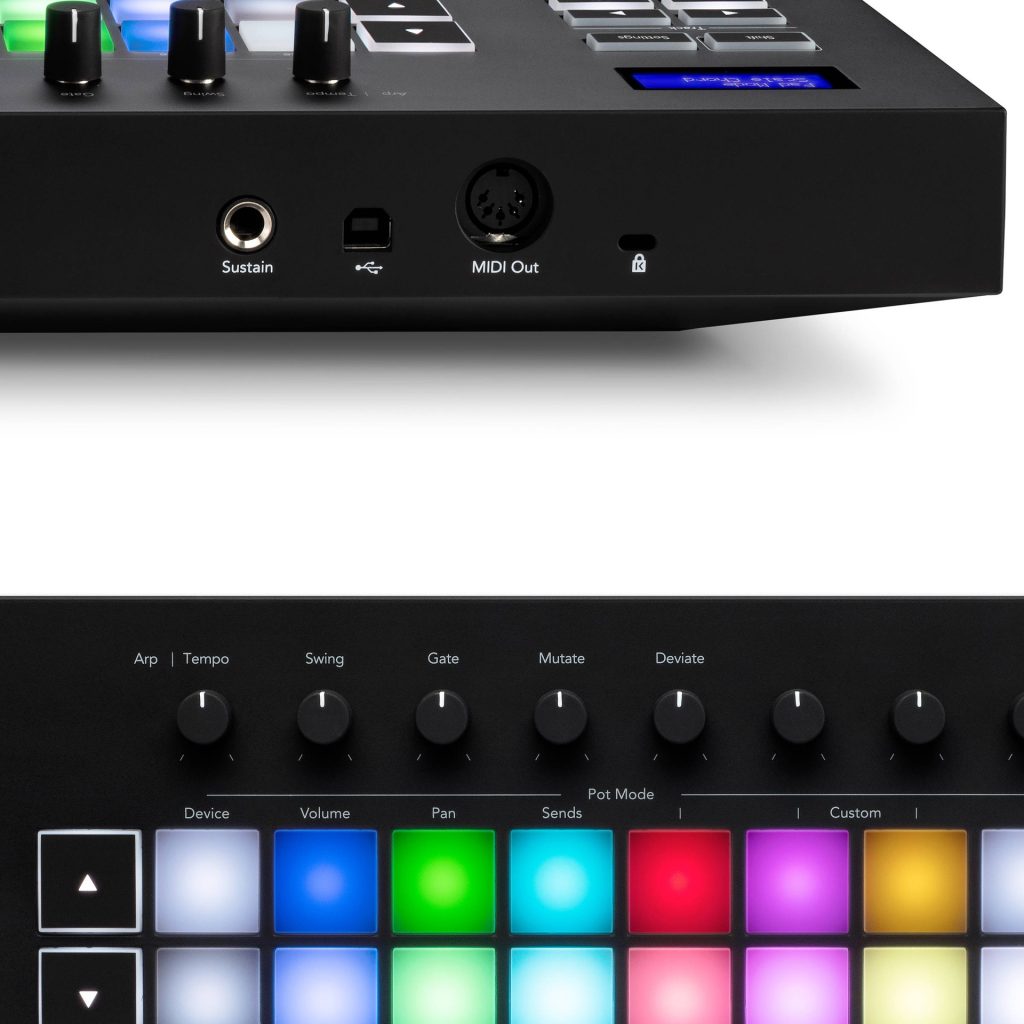
- A synthesizer is a musical instrument that generates sound
- A MIDI controller is like a remote control that controls a different synthesizer or MIDI device
- On its own, a MIDI controller cannot be used as a synthesizer and will not generate any sound
What is the purpose of a sequencer?
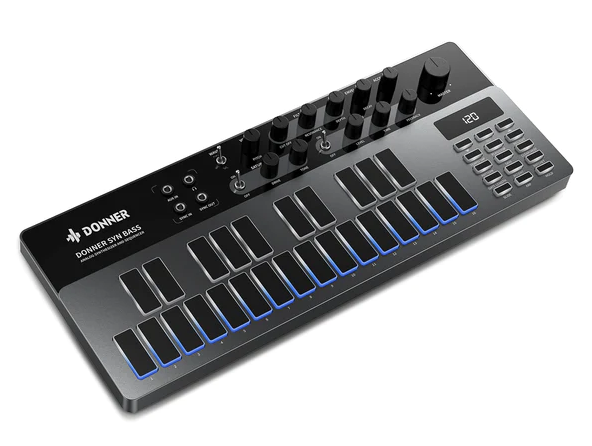
A synthesizer’s sequencer — as found on the Donner Essential B1 — allows you to enter a series or “sequence” of notes for your synthesizer to play, allowing you to tweak knobs or audition new sounds while your musical phrase loops continually.
There could be many reasons to do this: experimenting with different notes during songwriting, looping a bassline while you play leads over it, and generating evolving soundscapes are all things you could use a sequencer for. The important thing to know is that if your mini synth has an onboard sequencer, you can tell it exactly what to play, tweak knobs while it’s playing to add some sonic interest, and save the part for later performance or recording.
- A sequencer can be used to tell a synthesizer what to play and how to play it
- Some sequencers may only allow you to enter notes, others may capture knob movements to record techniques like filter sweeps too
- If your mini synth doesn’t have a sequencer, you may still be able to send it sequences from an external sequencer or DAW software
What is the difference between a sequencer and an arpeggiator?
While a sequencer allows you to enter a custom series of notes for your synthesizer to play, a synthesizer’s arpeggiator will generate new notes that are musically related to whatever notes are being played. In other words, a sequencer will tell your synth what notes to play, and an arpeggiator will add to those notes as they’re played. If you record a sequence while holding a chord and play the sequence back, you’ll heard the chord being held. If you engage an arpeggiator while holding the chord, you’ll hear the individual notes of the chord being played in a pattern, and may hear new notes outside of the original chord being generated.
Many mini synths, like the Arturia MicroFreak, feature a sequencer as well as an arpeggiator. Both can be great creative tools for both production and live performance, depending on what your musical goals are.
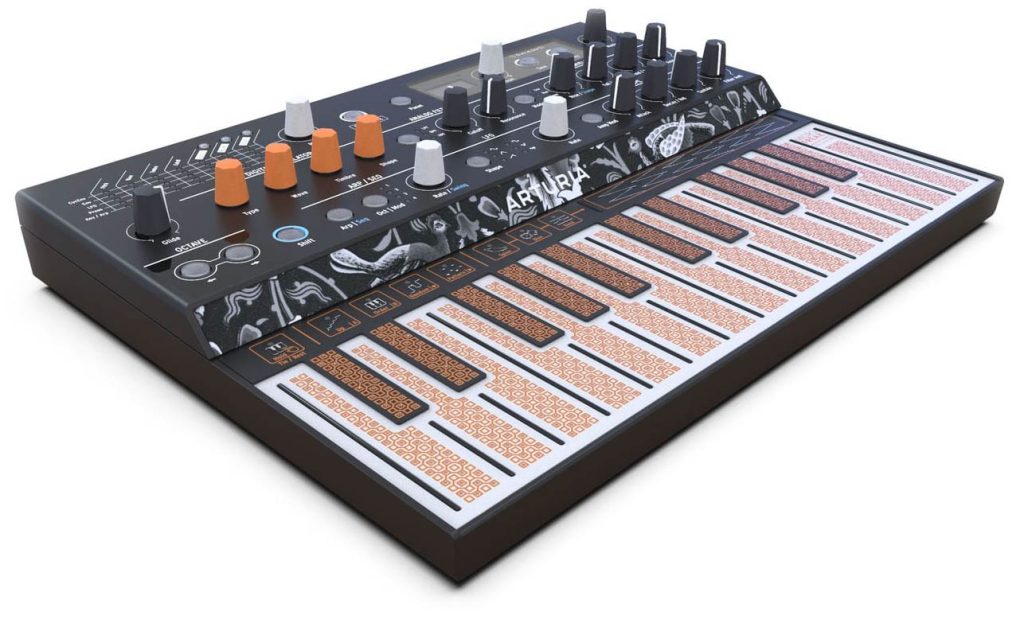
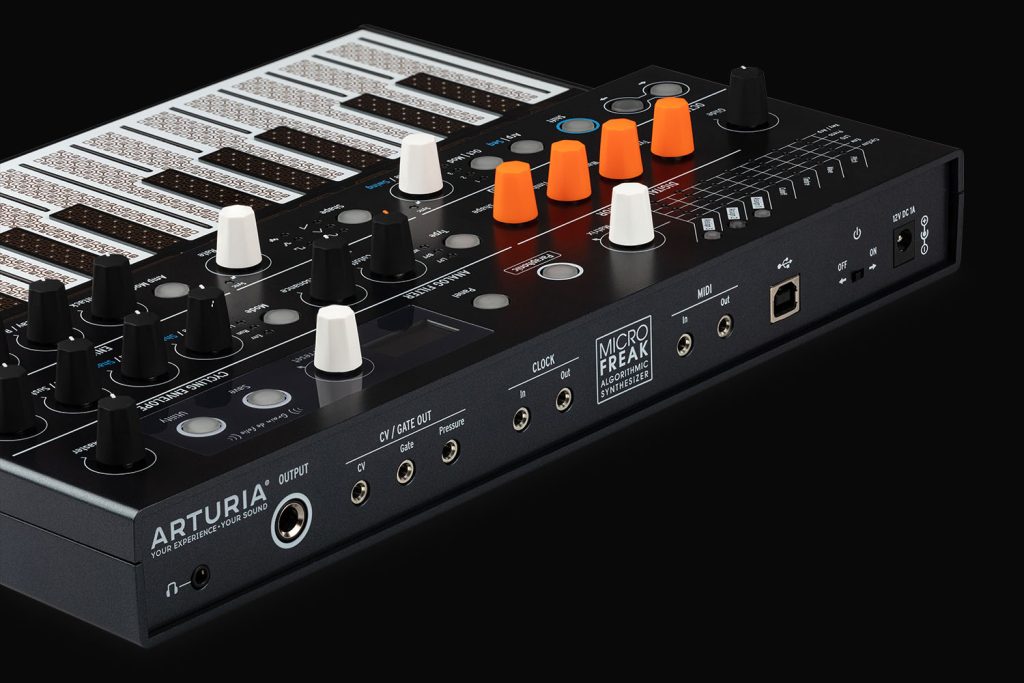
- A sequencer allows you to enter a series of notes to be played back by the synthesizer, like a player piano
- An arpeggiator waits for incoming notes, and generates new notes that are musically- and tempo-relevant
- Many synths that feature an onboard sequencer will also have an arpeggiator, but make sure the mini synth you’re looking at has what you want before buying
Should I get an analog or a digital mini synthesizer?
There are a lot of different ways we could compare analog and digital synthesizers: the important thing to know is that both are capable of creating world-class sounds and music. And whether you choose an analog or digital synthesizer should be based on the type of sounds you want to create, and the style of music you want to produce. Most digital synthesizers can create the same type of synth sounds as you could on an analog synth, but an analog synth cannot create all the sounds that a digital synth may be capable of. That’s a very general statement, but it holds true.
Analog synthesizers like the Moog Subsequent 25 are known for their epic bass and snappy, punchy lead sounds, both of which are the result of analog filters and envelopes.

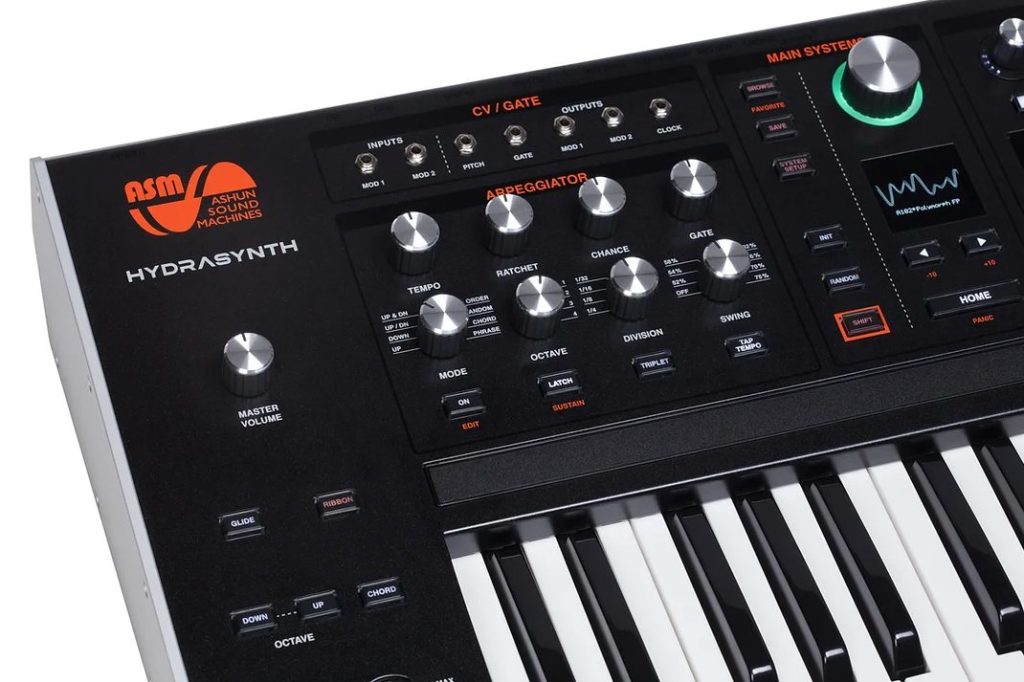
Digital synthesizers like the ASM Hydrasynth Explorer can do things you simply cannot efficiently achieve with analog circuits, such as frequency modulation (FM) synthesis and wavetable synthesis.
Both are outstanding instruments, but can serve very different purposes. Don’t worry too much about whether your mini synth is analog or digital: just listen to some demos and make sure it can make the type of sounds you want before you buy!
- Analog synthesizers are built with discrete analog components, and often offer dedicated controls and knobs for all features
- Digital synthesizers use a microprocessor to generate sound, and may require menu navigation to access all features
- While both analog and digital synthesizers can create world-class music, digital synthesizers will generally offer a great range of sounds to explore
How do you record audio from a synth?
Whether you use your mini synthesizer to create melodies, bass lines, chord progressions, or ambient soundscapes, at some point you’ll want to record your creations to DAW software on your computer or a portable recorder. Most mini synthesizers have line-level outputs for connecting to an audio interface or recorder. Some mini synthesizers have a headphone output that can be used for this too. To get the best signal to noise ratio, turn the volume on your synthesizer all the way up, and then set the input levels at your audio interface or recorder so that your recording does not clip.
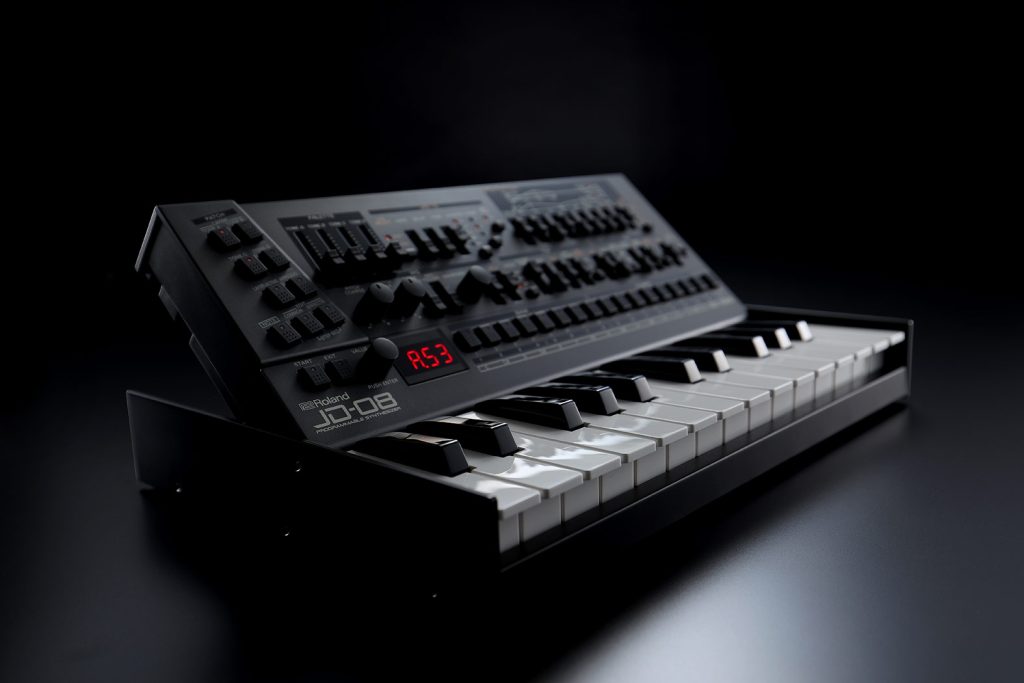
You may be wondering, can I record audio from my synthesizer to my computer with USB? Some synthesizers like the Roland JD-08 (shown here with the Roland K-25M Boutique Module Dock) can send audio to your computer with a single USB connection, while others only use the USB connection for MIDI communication and firmware updates. If you’re looking at a mini synth and you see a USB port, don’t assume it will send audio to your computer: do your research to make sure it does what you need it to do!
- Most synthesizers have analog line-level outputs to connect to mixers and recording interfaces
- For best results, turn up the volume on your synth to at least 75% and set recording input levels so that no clipping occurs
- Some mini synths can record to DAW software with a USB cable, but not all synths with a USB port offer this feature
Discover your creativity with a mini synth
It’s okay if you don’t understand every single feature your mini synthesizer offers before you dig in. Discovery is a core part of the fun of synthesis, and you’ll learn plenty as you explore the nuances of any synthesizer. And no matter which mini synthesizer you choose, if you take the time to learn its abilities inside and out you’ll be well-prepared to work with practically any other synthesizer in the future. So listen to some audio demos, get yourself a mini synthesizer, and discover a whole new side to your musical creativity!
Was this article helpful? Check out our other articles like this one:
BEST SYNTHESIZERS FOR BEGINNERS
Best Synthesizers for 2022 | 5 Composer Approved Synths
Intro to Synthesizers: How to Choose Which Synth to Buy
5 Best Vocoder/Speech Synthesizers [Reviews & Buyer’s Guide]


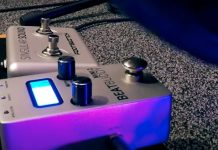
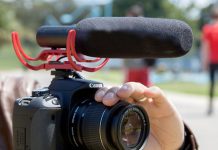




![5 Best Double Bass Pedals [Reviews & Buying Guide] Mapex - Best Double Bass Pedal Brand](https://homestudiohub.com/wp-content/uploads/2020/02/double-bass-drum-pedals-buyers-guide-80x60.jpg)




